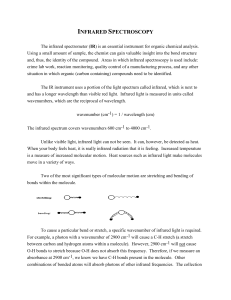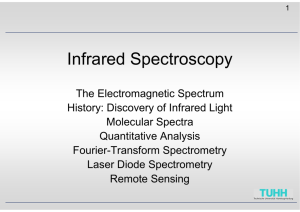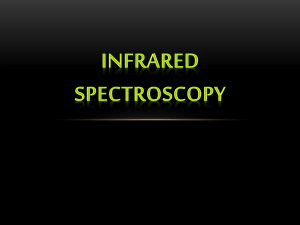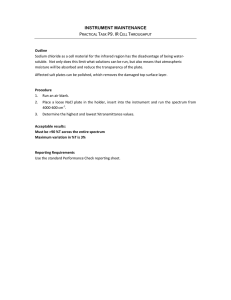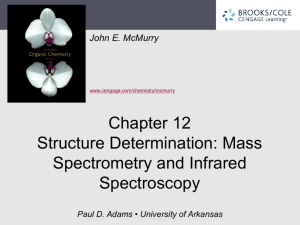Identification of Fibers using FTIR
advertisement
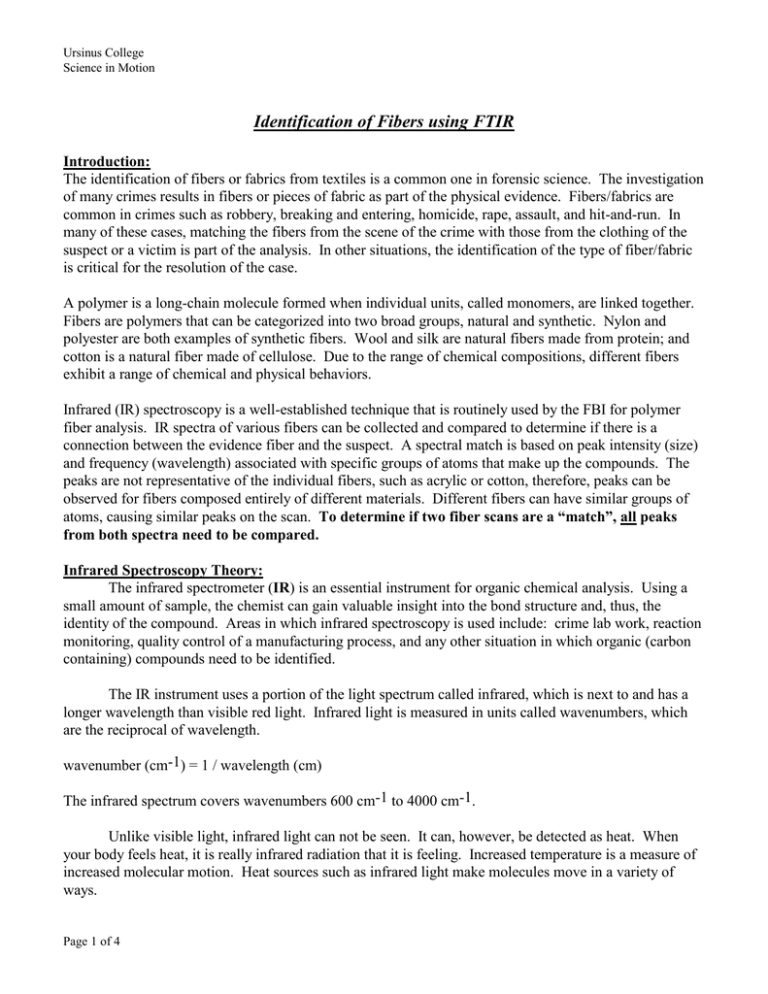
Ursinus College Science in Motion Identification of Fibers using FTIR Introduction: The identification of fibers or fabrics from textiles is a common one in forensic science. The investigation of many crimes results in fibers or pieces of fabric as part of the physical evidence. Fibers/fabrics are common in crimes such as robbery, breaking and entering, homicide, rape, assault, and hit-and-run. In many of these cases, matching the fibers from the scene of the crime with those from the clothing of the suspect or a victim is part of the analysis. In other situations, the identification of the type of fiber/fabric is critical for the resolution of the case. A polymer is a long-chain molecule formed when individual units, called monomers, are linked together. Fibers are polymers that can be categorized into two broad groups, natural and synthetic. Nylon and polyester are both examples of synthetic fibers. Wool and silk are natural fibers made from protein; and cotton is a natural fiber made of cellulose. Due to the range of chemical compositions, different fibers exhibit a range of chemical and physical behaviors. Infrared (IR) spectroscopy is a well-established technique that is routinely used by the FBI for polymer fiber analysis. IR spectra of various fibers can be collected and compared to determine if there is a connection between the evidence fiber and the suspect. A spectral match is based on peak intensity (size) and frequency (wavelength) associated with specific groups of atoms that make up the compounds. The peaks are not representative of the individual fibers, such as acrylic or cotton, therefore, peaks can be observed for fibers composed entirely of different materials. Different fibers can have similar groups of atoms, causing similar peaks on the scan. To determine if two fiber scans are a “match”, all peaks from both spectra need to be compared. Infrared Spectroscopy Theory: The infrared spectrometer (IR) is an essential instrument for organic chemical analysis. Using a small amount of sample, the chemist can gain valuable insight into the bond structure and, thus, the identity of the compound. Areas in which infrared spectroscopy is used include: crime lab work, reaction monitoring, quality control of a manufacturing process, and any other situation in which organic (carbon containing) compounds need to be identified. The IR instrument uses a portion of the light spectrum called infrared, which is next to and has a longer wavelength than visible red light. Infrared light is measured in units called wavenumbers, which are the reciprocal of wavelength. wavenumber (cm-1) = 1 / wavelength (cm) The infrared spectrum covers wavenumbers 600 cm-1 to 4000 cm-1. Unlike visible light, infrared light can not be seen. It can, however, be detected as heat. When your body feels heat, it is really infrared radiation that it is feeling. Increased temperature is a measure of increased molecular motion. Heat sources such as infrared light make molecules move in a variety of ways. Page 1 of 4 Ursinus College Science in Motion Two of the most significant types of molecular motion are stretching and bending of bonds within the molecule. To cause a particular bend or stretch, a specific wavenumber of infrared light is required. For example, a photon, a unit of light, with a wavenumber of 2900 cm-1 will cause a C-H stretch (a stretch between carbon and hydrogen atoms within a molecule). However, 2900 cm-1 will not cause O-H bonds to stretch because O-H does not absorb this frequency. Therefore, if we measure an absorbance at 2900 cm-1, we know we have C-H bonds present in the molecule (refer to the attached IR Peak Location Index). Other combinations of bonded atoms will absorb photons of other infrared frequencies. The collection of all absorbances between 600 and 4000 cm-1 constitutes the infrared spectrum for that molecule. This can be thought of as a molecular fingerprint. Just as people have unique fingerprints, molecules also have unique fingerprints. Identical molecules have identical fingerprints. Since every molecule has a unique arrangement of bonded atoms, every molecule absorbs a different set of infrared frequencies. For example, all molecules or samples of ethyl alcohol will have identical fingerprints (infrared spectra), but a sample of rubbing alcohol (propanol) will have a different fingerprint than ethyl alcohol. A source generates light across the spectrum of interest. A monochromater (in IR this can be either a salt prism or a grating with finely spaced etched lines) separates the source radiation into its different wavelengths. A slit selects the collection of wavelengths that shine through the sample at any given time. In double beam operation, as shown in the diagram, a beam splitter separates the incident beam in two; half goes to the sample, and half to a reference. The sample absorbs light according to its chemical properties. A detector collects the radiation that passes through the sample, and in double-beam operation, compares its energy to that going through the reference. The detector puts out an electrical signal, which is normally sent directly to an analog recorder. A link between the monochromater and the recorder allows you to record energy as a function of frequency or wavelength, depending on how the recorder is calibrated. Page 2 of 4 Ursinus College Science in Motion Procedure: Collect a background spectrum (only if you are the first group of the day) 1. Remove any sample from the sample compartment or accessory. 2. Using the mouse, click on Collect, Background. 3. Enter a spectrum title. Suggested title: initials bg date 4. Choose OK. A gauge shows the progress of collection. Collect a sample spectrum 5. Place sample on sample compartment or accessory. a. If using a swap-top accessory, turn and pull the silver release knob at the back of the swap-top (on the right side of the accessory). b. Once the release mechanism is disengaged, tilt the pressure device out of the way. Tilt it back until the silver release knob clicks into the back position c. Place sample on the base of the accessory so that it lies on the small hole in the base. d. While holding the pressure device, pull the silver knob out and move it to the upright position so the tip is now over the sample. e. Turn the top knob clockwise until it clicks. The instrument automatically determines the appropriate pressure necessary to run the sample. 6. Press Collect, Sample 7. Before it is displayed, the sample spectrum is automatically ratioed against the current background. In other words, the background is subtracted from the sample. 8. Print your spectra by selecting the bottom left menu button, and then Print. Note: The subtraction command is only used to subtract one sample from another. Unlike other infrared specs, the background scan is automatically ‘ratioed’ or ‘ or ‘subracted’ from the sample scan. Analysis: 1. Compare the results of the fabrics from the Fabric Mart. What can you conclude? What did you base this on? 2. Some IRs use salt plates to place the sample on. Since salt plates can be used for this experiment, what can you conclude about the interaction of salt with infrared radiation? Page 3 of 4 Ursinus College Science in Motion IR Peak Location Index Page 4 of 4

